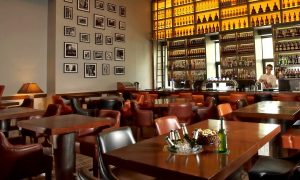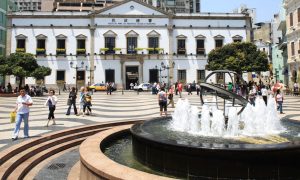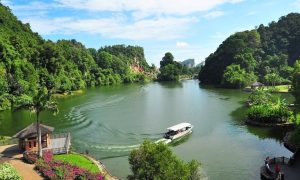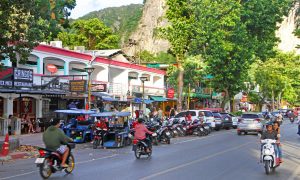Tombstones of Famous People in Penang

[img_gallery][/img_gallery]
Join John Harper as he explores Penang’s history in the Protestant Cemetery, where tombstones can tell the story of the men who shaped the island.
The protestant cemetery is a cool place, where very old trees provide shade and high walls provide a feeling of peace. It is a haven in the midst of a busy city, a welcome respite from the hustle and bustle of George Town life.
As cemeteries go, this resting place is a tourist attraction on a par with Highgate Cemetery (famous for Karl Marx and Douglas Adams) or Père-Lachaise Cemetery (where Jim Morrison of the Doors and Oscar Wilde reside), and yet predates both. Although the cemetery was founded as a purely functional burial ground, much needed in a hostile climate and terrain, it has become a historical record of Penang’s foundations.
Finding the Tomb of Francis Light It’s the inhabitants that dictate the popularity of a cemetery and, for such a small area, Penang excels in this category. The founder of Penang, Captain Francis Light (1740-1794), rests here. Born in 1740 to an unnamed father, Light was raised by William Negus and educated with Negus’s children. (Negus has been assumed to be his father, although later generations of the Light family deny it, suggesting that there may be an even nobler ancestor in the wings.)
While in the Royal Navy, Light got acquainted with James Scott, and the pair roamed the Empire seeking their fortune. Light started his upward trajectory when he managed to get the Sultan of Kedah to cede (what eventually became) Penang to the East India Company in return for protection from the Siamese, who attacked his territory. Eight years later, aged 54, Light was dead, stuck down by malaria, the “white man’s death” disease.
Finding Light’s grave is not the easiest of tasks as few realised how signifi cant his plot would later become. From the entrance of the cemetery, walk approximately twothirds of the distance alongside the wall and turn right just after the first pathway. The map at the entrance shows the plot clearly, but identifying it is harder as it’s not in the best of repair and the tomb is smaller than one would imagine for such a prominent figure. The nearby tombs of Light’s contemporaries – Phillip Dundas, Governor during the Penang Presidency administration, and John Hope Oliphant, both of whom died from the dreaded “fever” – are substantially larger and easier to locate.
James Scott and the Bayan Lepas Connection
James Scott (1746-1808) is also buried here. He was the first cousin (once removed) of Sir Walter Scott and served in the navy during the Seven Years War, before travelling to the East Indies as a “country trader.” When Light died, it was Scott who took over his affairs, to the detriment of Martina Rozells, Light’s “wife,” who was of Portuguese and Siamese lineage and the mother of his six children.
The take-over made Scott the largest landowner at the time, but Scott died a bankrupt due to his failed investment in James Town (now Bayan Lepas) where he had hoped the Empire would open a naval base. It took many more years before the invention of the airplane and the creation of shopping malls made it a profi table location.
As an aside, it seems Scott was married to Dorothy “Dolly” Quincy when he died, who had previously been the wife of John Hancock (the first signatory of the Declaration of Independence of the American colonists).
A Nutmeg Planter in Penang
David Brown (1778-1825) was also a contemporary of Light and the eventual winner in the race for riches. A Scotsman from a small village in Berwickshire and born in 1778, Brown studied law in Edinburgh and went into business with his fellow Scotsman, James Scott, who came from the same village. When James Scott died in 1808, David Brown took over his estate and became one of the biggest landowners in 19th-century Penang.
One of the properties he owned was the Glugor Estate, which was planted with nutmeg and other spices. He brought in Tamil workers from India to work his estate and, in return, set aside some land for them to build their village, rear cows and goats, and plant fruit trees. This village of coconut trees had about 300 residents staying in 24 houses and was known as Kampung Buah Pala (Nutmeg Village). It remains one of the largest Indian communities in Penang, and is now better know now as Ayer Itam.
These men lived in extraordinary times: slavery was on the point of being abolished, the Industrial Revolution was beginning, the Empire was expanding. Things were changing fast, and there were fortunes to be made. Born into the age British Sea Power, these men took full advantage of what it offered them and, in the same way as cyber technology has produced great wealth today, they made their fortunes with cloves, pepper, and nutmeg which were, in their day, equally valuable commodities.
The King and I
Less notable personages that possess interesting stories are also interred in the Protestant Cemetery, such as Thomas Leonowens. Leonowens is best known as the husband of Anna Leonowens, a gentlewoman who married Thomas against her parents’ wishes, and was left an impoverished widow when he died of an apoplexy.
Anna solved her financial predicament by setting up a school for officer’s children in Singapore, which led to her being asked to educate King Mongkut of Siam’s children. The king wished to provide his 39 wives and concubines and 82 children with a modern Western education on scientifi secular lines, looking to replace a string of former missionary teacher; a move which may have stopped the subsequent conversion of Thailand to Christianity.
Anna seems to have taken considerable pains to hide her Anglo-Indian mixed blood heritage, including name changes and a refusal to acknowledge her family throughout her life. Her nephew, William Henry Pratt, also adopted a new name (not surprisingly) and became Boris Karloff and a star via his Frankenstein acting role. Anna’s husband, Thomas Leonowens, had been an army pay clerk, fathering a daughter (Avis) and son (Louis), the latter being Anna’s companion in Thailand during her English teaching period. Louis eventually returned to Thailand after a long period of wandering the world, living variously as a stockman and a policeman in the Australian Gold Rush, before using his friendship with the King’s son, Prince Chulalongkorn, to become fi rst a Capitan of the King’s Cavalry and then a teak trader of great success. He also owned the Oriental Hotel in Bangkok.
Later History
The cemetery interred its last occupant in 1892, scarcely more than 100 years after it was opened. It holds nearly 500 graves, a quarter of which no longer have readable inscriptions and are thus not identifiable. The cemetery was partially restored in 1993, and further restoration attempts were made in 2012 which resulted in some controversy over the quality of the works conducted. It has been agreed that a continuing process of repair and restoration should be begun on what is, after all, a Category 1 Conservation site under UNESCO World Heritage protection. Hopefully, the future of this cemetery is now secured.
Take a Tour
A free tour of the cemetery is run by Clement Liang of the Penang Heritage Trust on the third Sunday of each month. The group meets at the Penang Street Market at 2pm. Booking ahead is required, and can be done with the Penang Heritage Trust on 04.264 2631 or [email protected]. It’s advisable to choose clothing that will cover arms and legs and to apply anti-mosquito lotion before visiting the cemetery.
Source: Penang International August/September 2013
Read more:
- On the Trail of Francis Light, Founder of Modern Penang
- A Brief History on Francis Light and Penang
- Francis Light; From Illegitimate Boy to Founder of Penang’s British Colony
What are your thoughts on this article? Let us know by commenting below.No registration needed.
"ExpatGo welcomes and encourages comments, input, and divergent opinions. However, we kindly request that you use suitable language in your comments, and refrain from any sort of personal attack, hate speech, or disparaging rhetoric. Comments not in line with this are subject to removal from the site. "



















